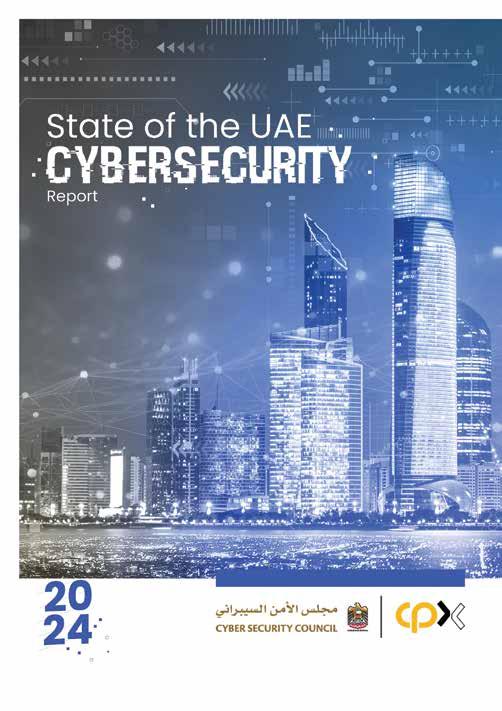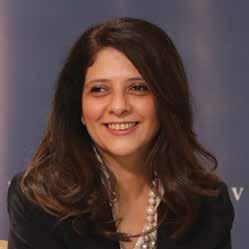














































































To have a productive workforce, companies must empower their employees! Establishing a positive organizational culture is recognized as a longterm endeavor. The COVID-19 pandemic has underscored the viability of remote work across various sectors. Today, we understand that there is no one-size-fitsall solution.
In this edition, we delve into the multifaceted topic of hybrid work and its intersection with technology. We explore this concept from diverse angles, including technological, social, and facility perspectives. As we delve deeper, we uncover the complex interplay of factors shaping work policies, some of which are beyond our control.
Modern professionals seek fulfillment and personal growth beyond mere financial incentives. For leaders and business owners, the focus is on nurturing growth, retaining talent, and creating new opportunities. This edition provides insights into achieving a balance in life, understanding the blurred nature of modern work-life boundaries, and navigating the evolving work landscape.
Our issue covers a range of topics, from commuting challenges to techniques for unwinding after a challenging workday. The past couple of years have demonstrated the importance of embracing new technologies and approaches to life. Hence, we are compelled to discuss the significance of social interactions, such as sharing a coffee, alongside the rapid technological advancements that provide opportunities to create flexible work environments. With technology playing an integral role in all major organizations, it has become easier to identify talents, ignite passion, and accomplish tasks meaningfully. Therefore, failing to capitalize on these opportunities signifies missing out or even struggling to adapt to the dynamic nature of work life.
Indeed, it has now become crucial to adapt to change and embrace flexibility as a new mindset to navigate life successfully. The Integrator urges us all to embrace these changes and move forward without clinging to old routines or lingering suspicions.
Vivek Sharma Founder
Sidra Kamal
Faiz Ahmed
Priyanshu Ranjan Sales Head
Sidharth Bhardwaj
Sales Manager
Gladwyn Pereira Sr. Media Sales Executive
Zain Fazal Sankay Media Sales Executive
Trishla Bhattacharya Media Sales Executive
Pratik Bisht Media Sales Executive Published




16 Navigating Leadership in Male-Dominated Industries
20 Bridging Healthcare Gaps: How Hybrid Work is Revolutionizing Digital Healthcare
24 Harnessing Technology in Hybrid Work
Environments: Strategies for Success
18
Advancing Genetics: The Role of AI in Fertility Procedures

50 Galadari Automobiles Launches First-Ever ‘Mazda Cx-60 & Cx-90’ Models in UAE
36

40 Sitecore’s Perspective on the Region's Evolving Tech Landscape
42 Red Hat on Open Source Innovation and Market Expansion in Saudi Arabia
Group-IB Reveals Strategies for Staying Ahead in Cybersecurity
AUTOMOTIVE FINANCIAL HOSPITALITY
52 Ransomware Cryptocurrency Payments in 2023 Hit all-time-high of US$1.1billion
56

Adapting to the Future: Navigating Hybrid Workspaces in Hospitality
Before, instead of working from home, we used to bring work home, but during the pandemic, remote work became a necessity, and companies had no option but to offer it as a norm to protect people from the virus.
Covid was a massive social experiment under unique conditions. Most of us were productive because we were in survival mode. For younger and new workers who joined the company during the pandemic, it would have been troublesome, finding it hard to learn the nature of remote work and understand the company culture. Regular catch-up calls with teammates and managers became a norm, which were essential for staying connected. The reason for the smooth transition to remote work was due to technological advancements and the high level of connectivity provided by companies and governments worldwide. Now, the question arises: what is the future of work?
The changing nature of work has been turbulent; hence, we need to discuss it. Work from home is the fundamental shift that occurred during the pandemic, and we are transitioning to another normal – the hybrid work culture. There was a study conducted on the effects of office commutes on people. Commuting often causes more stress than the work itself, especially dealing with traffic congestion and overcrowded public transport.
Today, companies have been

contemplating the future of work, making this topic intriguing. We are all aware that nothing works all the time. Even during the pandemic, there were industries and people who had no option but to work on-site, such as those in the medical and pharmaceutical sectors, who helped navigate through tough times. Not all industries can fully adopt the hybrid work model.
Data worldwide shows an increase in people's working hours, making it harder to maintain work-life boundaries. Economist data reveals that parents of school-age children experienced more stress. However, the experience varied among individuals, depending on the tasks they were trying to accomplish.
As of 2024, full-time remote work has decreased, with many opting for a combination of remote and office work, seeking flexibility. This poses a major challenge for company owners and top-level executives. They need to consider various aspects of their company, such as security, collaboration, and networking architecture.
Creating a consistent and compelling hybrid work experience is vital for both employee and organizational value propositions. Recognizing the perception of remote work versus office work and being intentional about it can significantly improve our lives. And the current work landscape provides more choices than ever before in the history of human labor.
 By: Srijith K N Assistant Editor
By: Srijith K N Assistant Editor
In the evolving landscape of the tech industry, the transition to hybrid work models has been both a boon and a bane, especially for women striving to carve their niches in this competitive field. While these models offer unprecedented flexibility and the promise of a better work-life balance, they also introduce a new barrier: the digital ceiling. This phenomenon, akin to the traditional glass ceiling, represents the unseen yet formidable challenges that women face in advancing their careers in a hybrid work environment.
The adoption of hybrid models has undeniably democratized access to opportunities in tech, allowing women from diverse geographical and social backgrounds to participate more actively in the workforce. The flexibility to juggle personal and professional commitments without the daily commute has been a significant advantage, leading to improved productivity and job satisfaction among women.
However, beneath these benefits lies the digital ceiling, a complex layer of challenges that can impede women's career progression. Key among these challenges is visibility. In a world where physical presence often equates to productivity and commitment, women working remotely may find themselves out of sight and out of mind, struggling to get noticed and, subsequently, missing out on crucial opportunities for advancement.
Networking and mentorship have also transitioned to digital platforms, posing another hurdle. Building meaningful connections and finding mentors or sponsors in a virtual setting requires more effort and intentionality. The spontaneous, informal interactions that foster strong professional relationships are less frequent, making it harder for women to build the support networks essential for career advancement.
The digital ceiling is reinforced by unconscious biases that can flourish in remote settings. When interactions are limited to screens, there's a risk that performance evaluations become more subjective, potentially disadvantaging women whose contributions might be less visible or who may face stereotypes about their work ethic and capabilities.
Breaking through the digital ceiling requires deliberate
By: Sidra Kamal Content Contributor
action from both individuals and organizations. For women in tech, increasing visibility means actively participating in virtual meetings, sharing accomplishments with managers and teams, and seeking out high-visibility projects. Leveraging technology for networking is also crucial; platforms like LinkedIn, virtual conferences, and company-sponsored networks can be valuable resources for connecting with peers and industry leaders.
Seeking mentorship remains essential. Women should be proactive in seeking virtual mentorship and sponsorship opportunities, utilizing both formal programs offered by employers and informal networks. The key is to be clear about career goals and seek advisors who can provide guidance and advocate on their behalf.
Employers play a crucial role in dismantling the digital ceiling. This includes implementing transparent performance evaluation criteria that recognize the
contributions of remote workers, ensuring equitable access to opportunities for growth and advancement. Creating a culture of inclusion and equity, where all employees feel valued and supported regardless of their work location, is also vital. Investing in technology and training ensures that all team members, irrespective of their physical location, have the tools and skills needed to succeed.
By taking proactive steps to increase visibility, build networks, and seek mentorship, women can navigate these challenges and advance their careers. Similarly, employers must commit to creating equitable and supportive environments that recognize and value the contributions of all employees, regardless of where they work. As we continue to navigate the future of work, breaking through the digital ceiling is not just about advancing the careers of women in tech; it's about building a more diverse and innovative industry.


INCLUSIVE LEADERSHIP IN THE HYBRID ERA FOSTERING WOMEN'S EMPOWERMENT IN TECHNOLOGY
 By: Roshni Menon Content Writer
By: Roshni Menon Content Writer
In recent years, the world has witnessed an extraordinary transformation in how we work and interact, accelerated by the advent of the hybrid era. This shift has reshaped traditional notions of leadership, particularly in the technology sector, where innovation is supreme. Amidst this backdrop, the imperative for inclusive leadership has never been more pressing, particularly in fostering women's empowerment within the field of technology.
At its essence, inclusive leadership embodies a style that not only acknowledges but actively embraces diversity in all its forms. It transcends mere tolerance to cultivate an environment where every individual feels valued, respected, and empowered to contribute their unique perspectives. Inclusive leaders prioritize equity and fairness, recognizing the inherent worth of each team member and striving to create opportunities for all to succeed.
Despite strides in diversity and inclusion efforts, women in the technology industry encounter formidable barriers. From ingrained gender biases and stereotypes to systemic inequalities in hiring, promotion, and compensation, achieving gender parity remains an ongoing struggle. The underrepresentation of women in leadership roles exacerbates these challenges, perpetuating a cycle of marginalization.
Empowering women in technology transcends mere social justice; it is a strategic imperative for organizations navigating the digital landscape. Research consistently demonstrates that diverse teams foster innovation, creativity, and profitability. By harnessing the full potential of women in
INCLUSIVE LEADERSHIP IN THE HYBRID ERA IS NOT A MERE BUZZWORD BUT A FUNDAMENTAL PREREQUISITE FOR BUILDING RESILIENT, INNOVATIVE, AND EQUITABLE ORGANIZATIONS.
technology, organizations can unlock fresh perspectives, enhance problem-solving capabilities, and better serve diverse customer bases.
The emergence of women in leadership roles within the tech industry sends a powerful message, dispelling the notion that tech is solely the domain of men. These women serve as beacons, illuminating the path for others to follow. Their mentorship, investment in female-led startups, and advocacy for equal opportunities contribute to a supportive ecosystem where women can thrive.
While progress has been made, recent statistics reveal persistent challenges. Female attrition rates in the tech industry outpace those of men, with women of color experiencing particularly stark declines in representation. Despite heightened awareness, factors such as pandemic-related changes and layoffs have hindered diversity efforts. Effecting meaningful
change will require concerted action.
According to the data, 2022 saw an increased number of employees leaving all industries. The tech industry lost women (16%) at a higher rate than men (13.7%). Back in 2020, the numbers were almost equal.
Also, while hiring practices have increased diversity, we’re only seeing growth in leadership representation among white women. Women of color show a 76.5% decrease in representation from entry to exec level.
Even though awareness has grown, other factors, like pandemic-era changes and mass layoffs, have hurt diversity in the tech industry. Making real change will require a concentrated effort.
The rise of remote work and flexible schedules postpandemic presents opportunities for women to balance professional and personal commitments more effectively. Studies indicate that hybrid work arrangements have enabled women to pursue promotions and senior roles at higher rates, particularly among minority groups. This shift towards flexibility heralds a more inclusive professional landscape.’
IWG's 2024 report Advancing Equality: Women in the Hybrid Workplace, based on research among more than 1000 female hybrid workers, found that the flexibility of hybrid working had allowed over half (53%) to pursue promotions or apply for more senior roleswhich, in an encouraging move for advancing equality, rises to more than three in five (61%) of women from minority backgrounds. The Advancing Equality report, commissioned by IWG, the world's largest provider of hybrid working solutions with brands including Spaces and Regus, reveals hybrid working is opening new opportunities for women professionally.
Looking ahead, technology and innovation will play pivotal roles in advancing women's leadership. Digital platforms offer unprecedented opportunities for learning, networking, and leadership development. Technologies such as AI and data analytics hold promise for identifying and addressing gender biases in recruitment and promotion processes. Additionally, the emphasis on sustainability and social responsibility aligns with women leaders' strengths in ethical decision-making.
Inclusive leadership in the hybrid era is not a mere buzzword but a fundamental prerequisite for building resilient, innovative, and equitable organizations. By championing women's empowerment in technology through inclusive practices, organizations can drive sustainable growth and pave the way for a more inclusive future. It is time to embrace diversity and lead the charge towards a brighter, more inclusive tomorrow.






Preeya Malik is a US qualified lawyer who obtained her Juris Doctor from the University of Toledo (Ohio, USA) with a focus on Immigration Law. She went on to obtain a Masters in Law, specializing in Real Estate Development from the University of Miami (Florida, USA). Preeya has been a licensed member of the Florida and the District of Columbia Bar Associations for 13 years, maintaining good standing. She possesses a unique combination of in-depth knowledge in both commercial real estate projects and investment immigration, gained through a blending of her academic background and her experience in the legal departments of some of the largest developers in the United States, as well as positions held with the oldest and most reputed immigration law firms in Canada.
Preeya furthered her extensive experience and passion for investment immigration via her role as the Managing Director of Step Global, where over the past decade she has assisted in successfully raising funds for multi-billion dollar global projects from investors across the MENA region, including the GCC, Middle East, India, Pakistan, and Africa, and helping hundreds of families achieve their goals of migration to the US, Canada, and the EU respectively.
Step Global Group is an advisory firm
providing holistic guidance for its high net worth clientele. Comprised of a network of globally licensed lawyers, tax and immigration specialists, and real estate professionals, Step Global Group provides active advice targeting the various needs of the HNWI community throughout the MENA region.
Step Global’s Immigration arm provides bespoke investment immigration solutions for various countries. They act as a single point of contact for their clientele, ensuring smooth liaison between all parties involved in the immigration process to ensure the most optimal chances for approval of each client’s application for migration.
The USA EB-5 visa has been one of the most popular investment immigration programs for clients from the MENA region, and Step Global Group’s primary focus for over a decade. Preeya was one of the first individuals to introduce the EB-5 Program to the region, and continues to educate investors on this U.S. option as she has become well-known as a leader in US investment migration. Step Global has also placed clients in the Canada Start-Up Visa Program; a pathway for innovative entrepreneurs worldwide to establish their businesses in Canada. By linking aspiring business leaders with the Canadian ecosystem, the Start-Up Visa Program plays a pivotal role in diversifying the economy and positioning Canada as a global hub for innovation and entrepreneurship.
Step Global Group also provides Wealth and Tax Advisory to their high net-worth clientele, as well as Executive Lifestyle Management Services, representing the full 360-degree nature of their services. This can range from counsel on wealth management & international taxation planning, to concierge services such as providing shortterm Personal Assistants, travel and event planning and general lifestyle consultancy.
By combining migration with strategy, wealth planning, and cross-border tax structuring, Preeya and Step Global are committed to ensuring all of their clients’ ambitions are realized through personalized advisory and industry expertise, built over decades of experience in the immigration field. Preeya continues to be covered in major media and news outlets such as Forbes, Khaleej Times, Gulf News, and The Huffington Post as a thought leader in investment immigration.
Embracing challenges as avenues for growth stands as a hallmark of effective leadership. I firmly advocate for venturing beyond one's comfort zone and embracing risk, knowing that such bold steps often lead to significant success. Throughout my professional journey, I have consistently embraced courageous decisions, whether it was relocating from Paris to Dubai after 12 years or establishing my own freelancing enterprise in a new country. I have always confronted challenges head-on.
My career commenced with the completion of a master's degree in accounting and finance, concurrent with employment at a chartered accountant firm in Paris. This dual commitment enabled me to seamlessly apply academic theory to practical scenarios, enriching my expertise in the field. Subsequently, I diversified my skill set through strategic transitions within the automotive spare parts and pharmaceutical manufacturing sectors, gaining invaluable insights into supply chain management, quality control, and regulatory compliance by international standards.
Currently serving as the CFO & COO at Alpha Nero, my primary focus lies in ensuring robust financial management and strategic direction for the organization.
Drawing from my extensive background in automotive and pharmaceutical manufacturing, I've leveraged diverse skill sets and deep industry insights. In the automotive sector, I honed expertise in supply chain dynamics and logistics,
 By: Severine Hoss Chief Financial Officer, Alpha Nero
By: Severine Hoss Chief Financial Officer, Alpha Nero
while my tenure in pharmaceuticals ingrained a meticulous approach to quality control within regulated environments. I've implemented Six Sigma, 6S, and lean methodologies to streamline operations, fostering business efficacy and precision across departments.
My journey has been underscored by pivotal lessons that have shaped my leadership philosophy. Strategic thinking, aligned with business objectives, underscores the importance of understanding organizational intricacies. Effective communication and collaboration foster synergy between finance and other functional domains, driving informed decisionmaking. Adaptability remains paramount in navigating a dynamic business landscape, bolstering confidence in managerial instincts.
At Alpha Nero, a forward - thinking luxury shop fitting firm based in the UAE, I oversee financial operations while championing sustainability and growth. As CFO, I orchestrate budgeting, financial planning, and risk management, ensuring compliance and accuracy in financial reporting. Transitioning into the role of COO has empowered me to integrate financial acumen with operational prowess, driving sustainable growth strategies.
Undoubtedly, navigating leadership in male-dominated spheres presents challenges, including gender bias and limited representation. Overcoming these hurdles necessitates resilience, confidence, and a supportive team dynamic. Actively engaging with mentors, peers, and industry networks, alongside continuous professional development, remains imperative in staying abreast of evolving trends and regulatory landscapes.
Reflecting on my journey, I take pride in significant milestones, from establishing my own enterprise to contributing to Alpha Nero's exponential growth. Witnessing women excel across all levels within our organization underscores the transformative power of leadership diversity.
To aspiring women entrepreneurs and business leaders, I advocate self-belief, perseverance, and cultivating robust support systems. Embrace challenges, celebrate achievements, and steadfastly pursue your aspirations, embodying confidence and resilience in every endeavor.

 By: Dr. Mari Mitrani Chief Scientific Officer, Gattaca Genomics
By: Dr. Mari Mitrani Chief Scientific Officer, Gattaca Genomics

In my capacity as Chief Scientific Officer of Gattaca Genomics, my focus is on revolutionizing the genetic approach for patient access and enhancing fertility treatments through innovation. Our mission transcends mere advancement; it's about fundamentally transforming the landscape of genetic healthcare for individuals and families striving to achieve parenthood.
Access to our genetic traits bridges science, technology, and care, aiming to empower individuals with knowledge, guiding them through their genetic information, and providing steadfast support. At Gattaca Genomics, we are deeply committed to embracing this comprehensive approach.
Our latest initiative marks a significant leap forward in fertility and genetics, made possible by the integration of state-of-the-art artificial intelligence (AI) technologies. Through the utilization of AI algorithms, we are reshaping the processes of preimplantation genetic testing, whole genome sequencing, and genetic counseling, ushering in a new era of precision and efficiency.
The transformative power of AI lies in its ability to analyze vast genetic datasets with unprecedented accuracy and speed. Through sophisticated hyperparameter tuning and deep learning techniques, our AI systems identify anomalies and patterns in genetic data with unparalleled precision. By comparing extensive datasets, AI enhances the identification of genetic abnormalities such as aneuploidies and chromosomal structural abnormalities, contributing to improved detection and reliability in embryo screening.
Moreover, AI-driven large language models (LLMs) enable us to revolutionize genetic analysis in assisted reproductive processes. Our AI-driven neural network comprehensively analyzes genetic data from embryos, including preimplantation genetic testing (PGT) and full genome analysis, to discern crucial efficiencies and deficiencies, ensuring more successful outcomes for patients.
One of the key features of our AI tools is predictive analytics, which assesses the likelihood of genetic conditions and provides nuanced insights into embryo health. By leveraging personalized recommendations based on individual genetic profiles, we empower patients and healthcare providers to make informed decisions regarding embryo’s health status, thereby optimizing the chances of successful pregnancies.
Beyond its analytical capabilities, AI also plays a pivotal role in quality control processes, ensuring consistent and reliable genetic testing results while minimizing the risk of human error. Through continuous monitoring throughout the testing pipeline, our AI systems guarantee accuracy and reliability, thus maintaining the integrity of genetic data.
By automating various stages of genetic testing, AI streamlines processes, reduces turnaround times, and minimizes the risk of errors. Consistency in genetic analysis across screened embryos ensures standardized results and provides reliable decision-making support to healthcare providers and patients alike.
The integration of AI into genetics and fertility procedures represents a paradigm shift in the field of reproductive health. At Gattaca Genomics, we are proud to lead this transformative journey, leveraging AI technologies to enhance precision, efficiency, and ultimately, the success rates of fertility overall. Through our commitment to innovation and excellence, we aim to redefine the standard of care, offering hope and empowerment to individuals and couples on their journey to parenthood.
As the world navigates through the complexities of a post-pandemic era, one thing is abundantly clear: the traditional landscape of work has undergone a profound transformation. The rise of hybrid work models, blending remote and in-person work, has become the new norm across industries. While this shift has been primarily associated with corporate sectors, its impact on healthcare cannot be overstated.
The healthcare industry, long characterized by its conservative approach to technological advancements, is experiencing a seismic shift propelled by the adoption of hybrid work models. This transition isn't merely about embracing remote work tools or facilitating virtual meetings; it represents a fundamental restructuring of healthcare delivery, with digital transformation at its core.
In the midst of the COVID-19 pandemic, the United Arab Emirates (UAE) witnessed a profound transformation in healthcare delivery, driven by the convergence of hybrid work models and digital innovation. As the world adapted to new modes of working, the UAE's healthcare sector seized the opportunity to accelerate its digital transformation journey, revolutionizing patient care and access to services across the nation.
The UAE's youth population, with nearly 50 percent UAE's population between the ages of 15 and 35, coupled with widespread technology adoption exceeding 90%, has laid the foundation for the rapid integration of telehealth solutions into everyday healthcare practices. This integration has been further propelled by the flexibility offered by hybrid work models, enabling healthcare providers to seamlessly incorporate telemedicine into their services, thereby enhancing accessibility to care, particularly in remote or underserved areas.


Moreover, hybrid work models have spurred the development of robust digital health platforms, facilitating seamless collaboration among healthcare professionals irrespective of their physical location. These platforms integrate electronic health records, telehealth services, and data analytics tools, providing a holistic view of patient health and enabling personalized treatment plans.
The convergence of healthcare and technology isn't just about efficiency gains or cost savings; it's about democratizing access to care. By breaking down geographical barriers and overcoming logistical constraints, hybrid work models have the potential to address healthcare disparities and improve health equity. Rural communities, underserved populations, and individuals with limited mobility stand to benefit immensely from the democratization of healthcare services enabled by digital transformation.
However, the rapid pace of digital innovation in healthcare has raised concerns regarding data privacy, cybersecurity, and regulatory compliance. As healthcare organizations embrace hybrid work models and leverage cloud-based solutions, safeguarding patient information and maintaining regulatory compliance must remain paramount. Robust cybersecurity measures, stringent data encryption protocols, and regular compliance audits are imperative to ensure the integrity and security of patient data.
The telehealth market in the UAE is poised for exponential growth, with forecasts indicating a staggering expansion to over US$536.5 million by 2025, representing a remarkable CAGR of 25% from 2020 to 2025. The virtual visit segment is expected to witness exceptional growth, surging from US$73.5 million in 2020 to US$280.7 million by 2025, fueled by employer health plans increasingly offering these services as member benefits. This paradigm shift underscores a broader trend towards preventative care and digital health initiatives, propelled by government-led initiatives aimed at revolutionizing healthcare delivery.
These aims align closely with the mission and vision of innovative digital healthcare organizations, which are committed to revolutionizing healthcare delivery through evidence-based, patient-centric care. By leveraging cutting-edge technology and embracing hybrid work models, such organizations can drive digital transformation in healthcare, ensuring that every individual, regardless of their location or background, has access to high-quality, affordable healthcare services.
By embracing innovative solutions and adopting a patient-centric approach, we can build a more accessible, efficient, and equitable healthcare system that meets the needs of all individuals.

 By: Amanda Steger Vice President of Engineering, Forcepoint
By: Amanda Steger Vice President of Engineering, Forcepoint

As businesses continue to navigate the proper balance between hybrid and remote work, the traditional boundaries of the office have expanded, turning everywhere into a potential workplace. As a result of this continued approach to hybrid work, businesses must identify a new approach to cybersecurity, one that prioritizes data security in the face of diverse challenges posed by remote employee culture.
Unsurprisingly, remote employee culture has significantly altered the cybersecurity landscape: Employees accessing corporate resources from various locations and devices has become the norm, making it crucial for organizations to implement strong cyber protective measures. This shift has accelerated the already immense challenge where Bring Your Own Device (BYOD) and unsanctioned applications and tools (Shadow IT) are utilized, posing a challenge for security teams to monitor and gain visibility into the movement of data across businesses.
To establish a remote culture that is as secure as possible, security leaders must prioritize security awareness among employees. This involves educating them about potential threats, emphasizing adherence to established protocols, and implementing comprehensive security awareness training programs.
Mitigating remote worker risk may be challenging, but organizations can significantly alleviate risks by adopting proactive measures and extending data protection to wherever workers are. A level of acceptable risk must be defined based on the nature of the business and the sensitivity of the data involved. However, striking a balance between security and productivity continues to remain an essential area of concern, as it has in recent years. This brings us to three key challenges that must be addressed in hybrid work security.
First, it is crucial to secure both cloudbased and private web applications. With the use of multiple devices, employees often access corporate resources from various locations, making it essential to have robust measures in place to safeguard against potential threat actors and unauthorized access. Second, in today’s BYOD workforce, ensuring robust threat protection is essential, because malware and data breaches can come in many shapes and
forms. Protecting employees from the many types of emerging threats, such as sophisticated phishing scams, propagation of malware and ransomware, and credential theft, to name a few, remain a primary concern.
And third, perhaps most importantly, data security must be prioritized for both corporate and BYOD devices to maintain a secure environment. Uniform data security policies across all attack surfaces, including cloud, corporate devices, and BYOD, are essential. Data security teams must work to unify policy coverage across the different channels being used, including email, cloud, web, network, and endpoint, ensuring visibility regardless of the device in play.
As a solution, leveraging Zero Trust frameworks can play a critical role in developing a more secure remote workforce. Through a framework of “never trust, always verify,” organizations can authenticate users before granting access to business resources. This approach provides an additional layer of protection against account compromise. Pairing these aspects with the benefits of Secure Access Service Edge (SASE) can give organizations greater visibility of application usage across the network and a stronger grasp of their data across managed and unmanaged devices. By adopting a unified approach to security, businesses can simplify the task of securing their hybrid workforce, making it more manageable and effective in safeguarding critical assets and data.
The most crucial lesson for employees in the realm of remote security is to understand the shared responsibility they bear in safeguarding corporate assets. Employees must be educated about the risks associated with using personal devices and unsanctioned apps – prioritizing following security protocols, being vigilant about potential threats, and actively participating in ongoing security training programs. For the security leader, building a security-conscious culture among employees is key to creating a resilient defense against evolving cyber threats. Finally, staying on top of industry trends is imperative, because the collective and adaptive response to evolving threats strengthens overall cybersecurity posture. And in this transformative era, securing data everywhere it resides is not just a necessity but a strategic initiative.

Professor Fiona Robson, Head of Edinburgh Business School and School of Social Sciences at Heriot-Watt University Dubai


For many, working in a hybrid model of some working from home and some from organisational premises is seen as a positive scenario. However, it can also be a double-edged sword in terms of blurring the boundaries. Advantages include flexible working options and may open up a new pool of candidates who don’t want to or aren’t able to travel every day. The benefits of hybrid include the cost implications of not having to travel twice a day and not losing productive time when travelling. Not every role would be suitable for hybrid working, for example someone working in customer services or providing a service in the homes of clients. Offering hybrid working options gives the potential to increase employee retention by meeting their needs. It is also important to recognize that hybrid working shouldn’t be perceived as a part time role with part time organizational commitment. Leaders are responsible for developing a culture whereby all eligible employees are encouraged to work remotely for at least some of their working time.
There is research which suggests that employees who are able to work from home are more productive than in the office. This makes assumptions that a) employees don’t mind the blurring of boundaries with their home life b) that they will have appropriate space from which they can work and c) that appropriate technology and infrastructure (e.g. wifi) is available. Depending on the home situation, there may be more distractions when working away from the office if it shared with other people. Ultimately the decision around moving to hybrid working will need the leader to consult and then take all the factors into account to establish the potential impact.
Technology can be used to improve performance throughout an organisation, for it to be successful there are a range of factors which need to be in place. Firstly, selecting the correct technology that can meet the needs of the organisations and their users. Once selected, extensive learning and development support is needed so that users feel confident and competent in using it for their roles. If there is equipment or software which isn’t used regularly, some reminders and an offer of training may be useful. The health and safety of hybrid workers should be considered, ensuring
that remote working is organised and carried out in a safe way as part of the leader’s duty of care.
Technology is a good alternative where it isn’t possible for the leader to meet with all their employees. Software such as Teams and Zoom allow information to be shared instantaneously. Whilst there may be specific occasions where in-person is needed, many meetings can be online. Probably the biggest impact of the pandemic was how organisations had to pivot to be able to work remotely. For some employees, this was seen as a very good thing; having previously been told that it wasn’t possible for some roles, it was established that it could work. Hybrid working can also give time flexibility which may make international collaborations easier. Leaders should lead by example and highlight their own hybrid working, ensuring they have maximum visibility.
Potential disadvantages of hybrid working include having a negative impact on teamworking and morale which leaders may need to address. Opportunities for valuable ‘water cooler’ conversations are likely to take place less frequently might lead to missed chances for collaboration or process improvement.
Hybrid/remote working does not mean that all networking opportunities are lost; technology now gives us many ways to achieve this – again, learning lessons from the pandemic where many conferences and events were delivered wholly online. Platforms such as LinkedIn allow leaders to connect to people across the globe and build their digital network. Other specialist software encourages leaders and their employees to have some informal online ‘coffee break’ time.
As a leader, a key decision is the extent to which employee performance should be monitored. Technology is available to do this; however, it raises an issue of trust. There may be certain occupations where it is necessary for the organisation to have access to this data for security reasons. Data protection and privacy policies should be adhered to at all times.
Strong leaders recognise the importance of giving and receiving feedback and for this to be built into project plans rather than just at the end of the activity. Where hybrid working means fewer opportunities for face-to-face engagement, technology can be used via software that collects and stores employee feedback. Leaders need to role model good behaviour by visibly seeking and responding to feedback on their own performance.
As a leader it is important that the HR team are briefed to reflect the organisation’s commitment to hybrid working by ensuring that policies and practices do not disadvantage hybrid workers.
For example, reviewing internal promotion and performance review criteria to ensure they are appropriate. Updated IT policies should be considered, to reflect the needs of people who work at home and use secure data which would previously not have been available. Leaders should consider some of the sensitive issues around hybrid working, for example does it lead to the introduction of hot-desking. For some of their followers losing the artefact of their own personal space could be negative.
The use of AI in most organisations is still at a relatively early stage where many are only confident to dip their toes into the water. Where women leaders become early adopters of AI this can have a positive impact on the whole organisation. It also potentially provides the leaders themselves with a competitive advantage. Being upfront about the advantages and disadvantages will be useful as well as identifying where and when it might be used. The early inclusion of employees to influence the scope and implementation of AI is a worthwhile investment.
Many organisations collect data on a daily basis but don’t make the best use of it, and this is a missed opportunity. Leaders should invest in new hires who are experts in data analytics and can provide some bespoke use of technology to meet the specific needs of the organization. Importantly these appointments can upskill the existing workforce by learning in ‘real play’ rather than role play.
Whilst AI could lead to some disruption, sometimes that in itself encourages more innovation. Leaders have an ethical responsibility as well as a management one to ensure that AI is used appropriately and in compliance with regulations. Possibly the strongest opportunity at this stage for the use of AI to really make a difference, is collecting data on employee engagement on a continuous basis. This can be used to predict future behaviours and actions for the leadership team.
Leaders can use technology, for example, as part of their recruitment and selection processes so prospective candidates get a personalised experience. Personalisation could also be used as part of an employee engagement strategy. The use of AI isn’t a magic cure, and there will still need to be human interventions, particularly in the early adoption stages, to ensure fair decision-making.
Leaders’ HR teams will have to work with the experts to ensure that any potential negative outcomes of AI can be minimised e.g. if employees all start using Chat GPT for their work. Leaders will need their skills in managing change progress for an organisation that may find change very challenging.


 Charu Chanana Head of Forex Strategy, Saxo Bank
Charu Chanana Head of Forex Strategy, Saxo Bank
The price of bitcoin soared to all-time highs of over $69,000 on Tuesday before turning lower as some traders locked in profits. Gains have reached over 50% year-to-date, with much of the surge occurring recently as trading volume surged for US-listed Bitcoin funds.
Ethereum outperformed Bitcoin even as the SEC recently pushed back against Ethereum ETFs proposed by BlackRock and Fidelity. Markets are awaiting the SEC’s decision on the VanEck Ethereum ETF, which has its final decision deadline on May 23rd. Any approval, however, will likely come with the rest of the ETF filings as well, just like the spot Bitcoin ETFs, to prevent a first-mover advantage.

The first spot Bitcoin ETFs were launched in January this year, and investors are rushing to invest in them. Bitcoin spot ETFs have attracted everyday investors who want to buy digital assets through their brokerage accounts without going to a crypto exchange or to funds that track Bitcoin’s price through futures contracts.
BlackRock’s iShares Bitcoin Trust eclipsed $10 billion in assets Thursday, the fastest a new ETF has ever reached that milestone. Fidelity’s fund, with more than $6 billion in assets, is already the asset manager’s third-largest ETF and has accounted for most of its net ETF inflows this year.
The halving, also known as the "halvening," is a scheduled event in Bitcoin's protocol that occurs approximately every four years. During this event, Bitcoin miners' reward for validating transactions and securing the network is halved. This reduction in the reward decreases the rate at which new bitcoins are created, effectively reducing the available supply.
The halving aims to control inflation and ensure that the total supply of bitcoins remains capped at 21 million, as specified in Bitcoin's code. This scarcity is one of the key factors driving Bitcoin's value.
The next bitcoin halving is expected to occur in April 2024, when the number of blocks hits 740,000. It will see the block reward fall from 6.25 to 3.125 bitcoins. The general consensus is that Bitcoin halving events are positive for the price of Bitcoin, and historically, they have been.
The Fed’s overnight reverse repurchase agreement facility, or RRP—where eligible counterparties can park cash to earn a fixed rate—has been dwindling. This means that money market funds that parked excess cash at the RRP before have been withdrawing
it, particularly to buy T-bills, adding to market liquidity. As hinted by Fed member Chris Waller, the Fed may be at a point to start discussing the tapering of QT.
For those undecided about entering the crypto sphere, few things induce more FOMO (fear of missing out) than witnessing Bitcoin's ascent from the sidelines. Knowing others are making money while they're not can push people to take big risks. Indeed, FOMO serves as a potent catalyst for impulsive buying decisions.
Bitcoin provides an alternative asset choice for those looking to diversify away from government-controlled assets. This has been a factor supporting gold, as many central banks have bought gold over the last few years to diversify their USD reserves. Bitcoin could face a similar demand if it is increasingly accepted as the 'digital gold' of the 21st century. However, there are inherent risks to consider. Presently, Bitcoin's volatility makes it an unreliable store of value.
Bitcoin price action follows a high-beta cycle. When it rises, it rises fast, but when it falls, it also falls much quicker than other risk assets because of a high level of leveraged play in the crypto market. The recent run higher could have been a result of a short-squeeze, as strong ETF flows lead to higher prices and force some shorts to cover. Likewise, leveraged traders are forced to liquidate when the price declines, exacerbating the selloff. Thus, volatility is a key risk.
Also worth noting that speculative positioning is also long, which makes it potentially vulnerable to a reversal if ETF demand starts to moderate. Positioning in altcoins, such as Ether, is relatively more modest and long.

The UAE Cyber Security Council and CPX Holding cybersecurity report offers an in-depth analysis of the cyber threat landscape facing the UAE, emphasizing the critical need for advanced cybersecurity measures in response to the increasing complexity and sophistication of cyber threats.
Highlighting the urgency of the situation, the report has identified over 155,000 vulnerable assets within the UAE, with more than 40 percent of critical vulnerabilities remaining unaddressed for over five years. This
vulnerability, coupled with the surge in advanced cyber-attacks such as ransomware, underscores the essential need for robust cyber defenses in a region that is at the forefront of AI-driven technological innovations and geopolitical significance.
The report delves into key trends shaping the current cybersecurity challenges, including ransomware attacks, which represent over half of the cyber incidents. The Government, Energy, and Information Technology sectors are the most targeted by cyber threat actors, and traditional
attack vectors such as Business Email Compromise (BEC) and phishing remain prevalent, still posing a continuous threat.
The trend is further compounded by the financial repercussions of data breaches, with the Middle East, including the UAE, experiencing the second-highest data breach costs globally, reflecting the economic targets of cyber threat actors against the backdrop of Gulf prosperity. The rise in Distributed Denial of Service (DDoS) attacks further emphasizes the geopolitical intricacies of cyber threats,
necessitating a comprehensive and strategic defense mechanism to protect the nation.
H.E. Dr. Mohamed Al Kuwaiti, Head of Cyber Security for the UAE Government, said: “In an era marked by increasingly sophisticated cyber threats that pose significant risks to our national security, the imperative for collective vigilance and strategic action has never been greater. The entire ecosystem should engage proactively in reducing the UAE’s vulnerability to these threats. This report serves as an urgent call to action for all stakeholders to unite in enhancing our cybersecurity measures, thereby protecting our digital infrastructure and securing the economic well-being and safety of our nation.”
Hadi Anwar, Executive Director – Strategic Programs, CPX, added: “The latest cybersecurity report not only underscores the dynamic and evolving nature of cyber threats but also sheds light on the economic vulnerabilities at stake. The economic fallout from cyber incidents, as detailed in our analysis, necessitates a unified approach to bolster our national defences. Policymakers, companies, and individuals must collectively engage in strengthening our cybersecurity posture. This involves not just adopting advanced technologies and practices but also fostering a culture of cyber awareness and resilience. CPX is at the forefront of this mission, working closely with the UAE Cyber Security Council, to equip organizations with the necessary knowledge, tools, and strategies to safeguard against these threats, setting a new benchmark in cybersecurity excellence.”
The report also highlights the unique cybersecurity challenges faced by the UAE, including advanced persistent threats (APTs), the increasing reliance on digital infrastructure, and the sophisticated tactics of cybercriminals. Compiled by a consortium of cybersecurity experts, the report acts as a strategic guide for government entities, businesses, and individuals, providing actionable insights to navigate the complexities of the digital era. Key best practices to mitigate cyber risks

THE REPORT HAS IDENTIFIED OVER 155,000 VULNERABLE ASSETS WITHIN THE UAE, WITH MORE THAN 40 PERCENT OF CRITICAL VULNERABILITIES REMAINING UNADDRESSED FOR OVER FIVE YEARS.

highlighted in the report include:
• Implement Endpoint Detection & Response (EDR): Essential for effectively identifying and mitigating cyber threats, ensuring comprehensive visibility across digital assets
• Establish a 24/7 Security Operation Centre (SOC): Crucial for the continuous surveillance and management of cyber incidents, safeguarding digital ecosystems around the clock
• Leverage Cyber Threat Intelligence: Key to anticipating and neutralizing emerging cyber threats in real-time through informed, strategic decision-making
• Create and Implement an Incident Response Plan: A cornerstone of cyber resilience, ensuring preparedness and swift action in the face of cyber incidents
• Adopt Proactive Threat Hunting Processes: A forward-looking approach to identify and mitigate hidden threats, enhancing the overall security posture
As the UAE continues to lead in digital transformation, addressing these challenges requires a concerted effort from government entities, private organizations, and individuals to ensure the resilience and security of the nation’s digital landscape.

































Competencies, knowledge, experience, and confidence are all pillars and prerequisites of any successful manager, but women’s diverse views, attitudes, and mindsets can be an added value when creating a heterogeneous team. A STEM career for women often means being ‘one of the few,’ but this is not a barrier or a limit if we are not afraid to be ourselves and to define our own management style. We can succeed and drive more inclusion and social innovation. Make diversity your strength, your plus.
Embracing a hybrid work model has transformed my life, offering the flexibility needed to navigate diverse roles efficiently. This adaptability allows me to prioritize tasks, balancing work and personal commitments seamlessly. The flexibility fosters work-life balance, enhancing overall productivity and efficiency. Embracing this approach significantly contributes to my professional growth and well-being, making a notable difference in managing the diverse responsibilities within a day.

COVID-19 – gave rise to a WFH culture, wherein it was expected for employees to be available 24/7. Technologies evolved to provide a seamless experience. Today, we live in a connected world, wherein we carry our work on our devices. We don’t really need to be behind our laptops or in the office all the time. Having a hybrid work model is good, as it provides a fine balance wherein employees can manage their home as well as work, and employers can still maintain their core culture/ethos and ensure high productivity.


I want to take a moment to celebrate the incredible achievements and contributions of executive women around the world on the occasion of International Women's Day. The leadership, vision and resilience of all women leading the tech sector inspire all of us to break barriers, challenge norms, and strive for excellence in every aspect of our lives.
As we reflect on the progress made towards gender equality, let us also reaffirm our determination to creating inclusive workplaces where women can thrive and reach their full potential.

Integrator Media had an exclusive interview with Ashraf Koheil, Regional Director of Sales, META – Group-IB


Can you provide an overview of how does GroupIB stays ahead in the ever-evolving landscape of Cybersecurity?
Operating across over 60 countries worldwide, Group-IB continuously stays ahead in the dynamic cybersecurity landscape by closely monitoring and analyzing emerging threats. No business is immune to cyberattacks, so it is essential for organizations to adopt proactive measures to safeguard assets and maintain business continuity. Group-IB is committed to empowering organizations in the MEA region with cutting-edge cybersecurity technologies and expertise to navigate these challenges effectively and safeguard their digital assets.
One of the ways we help our partners is through our annual Hi-Tech Crime Trends report, which offers a comprehensive overview of evolving cyber threats in the Middle East and Africa (MEA) region.
In 2023, we identified a 68% surge in ransomware attacks, with financial services and real estate companies emerging as the most common victims. Additionally, our research revealed an increase in nation-state-sponsored attacks targeting MEA organizations, highlighting the region's vulnerability to advanced persistent threats (APTs).
What were the specific changes in cybercrime targeting the Gulf Cooperation Council (GCC) region in 2023 compared to the previous year, particularly concerning ransomware victims, compromised cards, etc?
In 2023, the Gulf Cooperation Council (GCC) saw a 65% surge in ransomware victims, marking a rise from 32 in 2022 to 53. This aligns with a global trend of increased compromised card incidents online. It's recommended that financial institutions adopt solutions like Fraud Protection to block fraudulent transactions and utilize up-to-date feeds of compromised sources from Threat Intelligence providers.
Regarding affected areas, the GCC led with 54 instances of access put up for sale, accounting for 31% of all detected offers in the region by Group-IB analysts, though this was 29% lower than in 2022. These access points, offered by initial access brokers, facilitate cybercriminal activities such as ransomware attacks. Despite this, there was a 29% decrease in offers for access to Middle East and Africa-based companies.
Additionally, the GCC experienced a significant 36% increase in the number of compromised banking cards made available on the cybercriminal underground, rising from 98,339 in 2022 to 133,320
in 2023. This reflects a global trend, emphasizing the importance for financial organizations to implement Fraud Protection solutions and utilize updated feeds of compromised sources provided by Threat Intelligence providers.
What factors contribute to the higher incidence of cybercrimes targeting Gulf countries, and does this suggest a lack of preparedness in terms of cybersecurity compared to other regions?
As more services and businesses take their operations online and look to introduce innovative solutions for their residents and clients, the more opportunities open up for cybercriminals to exploit these and potentially cause damage.
Across the whole globe, we have seen a significant increase in the number of ransomware attacks. Taking data from all countries in the world, we have seen a 74% increase in ransomware attacks in 2023, meaning that the growth in ransomware attacks in the GCC region is proportionally lower than the global average.
We have noticed that cybersecurity standards in the Gulf countries are rising significantly, in line with the digital transformations issued by governments across the region. Ransomware attacks can occur in any place, and at any time, and organizations must remain vigilant and take proactive steps to improve their cybersecurity posture.
How does Group-IB tailor its cyber protection solutions to meet the specific needs and challenges of various industries and sectors?
At Group-IB, we tailor our cybersecurity solutions to address the unique challenges faced by different industries. We believe in an integrated product and services ecosystem. In the face of evolving cyber threats, endpoint detection and response (EDR) and extended detection and response (XDR) solutions are increasingly crucial. Group-IB's Managed XDR combines technology and human expertise for proactive threat detection, resulting in a 20% faster response time.
In addition to Managed XDR, we spotlight to our Attack Surface Management, a pioneering cybersecurity solution enabling comprehensive assessment of external assets. Our Security Operations Centre consulting capabilities complement our suite of advanced cybersecurity solutions and services.
By customizing our solutions, we ensure that each industry receives targeted protection aligned with its risk profile.
How do you foresee technology further shaping the understanding of consumer behavior, especially in the context of hybrid work environments?
We have observed an improvement in consumer buying patterns since the advent of Covid 19. The smart technology has provided at-home comfort for many home buyers with larger appliances and has improved configurations too.
Consumers have now fully adopted hybrid working environments as they are fully equipped with the necessary hardware and upgrading home appliances to make home a fully functioning environment for work and play.
Key trends to witness here is that continue to emerge are larger capacity refrigerators, wireless/Bluetooth-enabled devices, premium small domestic appliances, and premium entertainment spending.
How do you plan to leverage technology to integrate and maximize the synergies between the two industry leaders to drive growth and innovation?
Many brands choose GfK to get a 360° view of their shoppers. To understand who the target segments are, what they are buying, and the reason behind it - to optimize marketing ROI and grow market share.
By fully understanding of consumer for a full basket. How they spend money and what they fill their shopping baskets with.
This also allows synergies in terms of retail landscape understanding and how promotional periods impact consumer purchasing behavior – the influx of entry-level products and the impact on consumer ecosystems.
How does GfK cut through data noise to deliver actionable insights using advanced analytics?
In a fast paced TCG environment, GfK is able to predict consumer behavior by considering the responsiveness to changes in everyday pricing and assist in forecasting future trends given existing market conditions. This enables our clients to make informed decisions; optimize their strategies and spend, and focus on what really matters for their business. This gives brands a lead time with the data provided that are insightful and qualitative.
Integrator Media had an exclusive interview with Nicolet Pienaar, Head of Intelligence and Retail, MENA, GfK.

 Nicolet Pienaar Head of Intelligence and Retail, MENA, GfK
Nicolet Pienaar Head of Intelligence and Retail, MENA, GfK

As someone experienced in leading digital transformation, how do you navigate the delicate balance between leveraging cutting-edge technology to enhance customer experience while ensuring seamless integration for clients transitioning into hybrid work models?
Disruption is often misunderstood as it carries negative connotations, however, innovation stems from necessity. This is the cornerstone in the Middle East where it is vital for OEMs to innovate to not only stay ahead of their game but more accurately, just to keep up with the consumer and overall market trends.
Consumers are more aware of working from home. GfK notes improvements in consumer understanding concerning purchases for at-home use.
GfK's mission is to drive "Growth from Knowledge." How do you envision technology playing a pivotal role in not only providing knowledge but also catalyzing growth for clients amidst the ever-evolving landscape of hybrid work and changing consumer behaviors?
The consumer landscape has diversified over recent years, and OEMs and Retailers must understand all pockets of consumers in order to accurately target strategies toward the relevant groups.
This opens the door for growth across OEMs and Retailers by accommodating the daily requirements of the advanced consumers.
How does technology play a role in maintaining and further enhancing this trust in an era where data privacy and security concerns are paramount, particularly in the context of remote and hybrid work setups?
Data privacy is a concern as technological advancements get better. The advent of hackers and processing power at their fingertips raise further concerns regarding the security of data assets.
A thorough training needs to be the focus for the industry as a whole and continuous monitoring must be implemented to ensure security measures. One needs to prioritize local servers, utilizing secure intranet or trust worthy VPN services.
How do you see technology reshaping traditional revenue models and business strategies in the wake of hybrid work trends, and what opportunities does this present for GfK and its clients?
Technology enables businesses to focus on efficient business practices, which in turn allows shareholder value to be maximized. Businesses are also now operating in significantly more volatile conditions, creating the need for businesses to be agile. This is further enabled by the technological advancements of online meetings and document sharing. International integration is more fluid making globalization possible. The Resource pool expands to ensure businesses can capitalize on top talent.


Integrator Media had an exclusive interview with Kristoff Copmans, Team Lead, Solution Architect, Sitecore
Please could you explain the digital transformation Sitecore is offering to companies and partners in the region.
In this region, there are several key elements that we must consider as we apply the power of Sitecore to address the problems and business challenges presented by our customers.
First and foremost, Sitecore has historically maintained strategic relationships with government entities across the region, including the UAE, Saudi Arabia, and other parts of the Middle East. This ability to drive e-government initiatives, digital transformation, and rapid digitization of services provided by government actors to citizens and companies underscores the importance of collaboration between the private and public sectors. Sitecore plays a pivotal role in this partnership alongside
our partners, facilitating the creation of e-government portals and delivering innovative experiences to citizens seeking government services.
The second pillar of our focus lies in the digital transformation of private sector companies. Dubai, often considered the nexus between East and West, serves as a hub for transportation, investment, finance, and innovation. It is imperative to support the ambitions of these customers with innovative digital solutions, whether through cutting-edge AI-based innovations, traditional digitization efforts postpandemic, or the shift towards modern commerce. This includes efforts to harness flexible data points within organizations, consolidate content, and scale operations to meet the demands of increasingly international markets. These endeavors highlight the pivotal role of content, data, and commerce as cornerstones of transformation, with both private sector companies and our partners continuing to invest in and deliver upon these capabilities.
Furthermore, Sitecore serves as an innovation partner within our ecosystem, collaborating closely with industry leaders such as Microsoft. With a longstanding partnership, Sitecore leverages Microsoft's expertise and solutions across various industry verticals, including digital retail and modern cloud services. Together, we aim to accelerate businesses towards new business models, innovate around channel management, and ensure that investments in open AI and Gen. AI translate into tangible improvements in customer interactions and business outcomes.
Could you provide an example of a government project that has undergone significant digital transformation and has changed the way the government operates in that sector?
Certainly, I can discuss the Telecommunications and Digital Government Regulatory Authority (TDRA). TDRA's objective is to catalog all the various methods through which citizens can interact with the Dubai government.
Their aim was to enhance citizen experience by leveraging advancements in Gen. AI and conversational interfaces. Rather than requiring individuals to visit a happiness service center or navigate government services manually, TDRA sought to introduce a more user-friendly approach. This involved utilizing Gen. AI. Sitecore, and Microsoft technologies to enable contextual interaction with the government, simplifying access to various ministry services.
Instead of searching multiple websites for information, users can now pose questions directly
to you. Ask platform, receiving comprehensive and accurate responses. By integrating conversational intelligence and leveraging government content as a source of truth, users can access a single interface for all their inquiries, streamlining their interactions with the Dubai government. This represents a significant transformation in government service delivery.
Furthermore, TDRA has explored innovative enhancements, such as introducing conversational avatars to provide a more human-like interface. By blending Gen. AI capabilities with humanization aspects, users can engage in natural conversations through digital interfaces, whether on websites, mobile applications, or digital signage. This advancement aims to replicate the experience of interacting with a human agent, bridging the gap between offline and online service delivery channels.
Overall, TDRA's initiative exemplifies the government's commitment to advancing digital transformation and enhancing citizen engagement, with ongoing efforts to further innovate and improve service delivery.
What are your thoughts on the evolving work landscape in a post-pandemic world- particularly on the importance of in-person interactions?
It's an intriguing question, as I must admit I lean towards the more traditional approach. There's something about stepping into the office in the morning, enjoying a refreshing drink by the water cooler, and sharing a morning coffee with colleagues that I find quite appealing. However, amidst this preference, I recognize the profound lessons the pandemic has imparted upon us. It's steering us not merely towards a hybrid world, but towards a realm of choice and flexibility. We now have the capability, thanks to technology, to engage with our customers wherever they may be. The boundaries that once hindered our ability to foster connections are dissipating, allowing for new ways of establishing contact and connectivity.
I find it remarkable that I can converse with partners in real-time, regardless of my location. This ability to bridge distances enables me to propel deals forward and connect with customers precisely when their needs are most pressing.
Yet, amidst this evolution towards a post-pandemic reality, one fundamental truth remains: people crave human interaction. Regardless of how hybrid or flexible our work arrangements become, there will always be a place for those moments of camaraderie over morning coffee in the office.

Integrator Media had an exclusive interview with Martin Lentle, VP, Northern Europe, Middle East & Africa, Red Hat
How do we all keep up with the fast pace of change of open source?
As the centre of innovation, open source represents the future of IT and is revolutionising software development methodologies. Moreover, the collaborative nature of open source greatly fosters innovation. As for Red Hat, we proactively participate in upstream communities to embrace this transition. Owing to its exposure to the newest technologies, our engineers are actively involved in this field, further providing us with insights into new trends and interests. This is significant as several businesses may find the landscape intimidating, given that managing a business requires a high degree of predictability, stability, and security. This is the point where Red Hat's expertise comes into play. We engage in upstream activities while providing customers with clear commitments related to lifecycle,


OVER 100 STARTUPS HAVE BEEN FOUNDED OVER THE LAST FEW YEARS IN ACCORDANCE WITH SAUDI VISION 2030, AND NUMEROUS VENTURE CAPITAL FIRMS HAVE BEEN ESTABLISHED WITH THE GOAL OF EMPOWERING YOUNG PEOPLE AND STEERING FURTHER GROWTH IN THE SAUDI MARKET.
security, and stability. Red Hat therefore strives to be the bridge that facilitates the seamless integration of opensource solutions into enterprise settings.
What customer needs do you see at the moment in the IT Industry?
It is imperative for all IT leaders to find a balance between embracing and managing change. The primary concern with this revolves around figuring out the ideal pace for each customer, particularly with regard to containerisation and orchestrating containers. Red Hat is firmly committed to giving customers the freedom to take charge of this journey and the choices they make along the way. Giving customers the tools to learn how to containerise apps is a key component of this strategy. This philosophy is reflected in our product offerings where we integrate automation and containerisation tools into Red Hat Enterprise Linux, to help customers get started with container building and deployment. Recognising the growing significance of automation skills, we have also improved training opportunities for Red Hat certified engineers. Simply put, we carefully evaluate and empower our customers with the right solutions based on their own needs and preferences, rather than forcing a predetermined course of action upon them.
LEAP will be back for the third year to bring together the global technology ecosystem. What is the significance of the LEAP conference for Red Hat?
The LEAP conference plays a major role in driving KSA's digital economy forward, attracting foreign investment, advancing women's empowerment in the tech industry, and preparing Saudi youth for success. Over the years, the event has grown into a major platform for promoting innovation and entrepreneurship in emerging sectors. This holds particular significance as the Gulf Cooperation Council (GCC) countries swiftly progress towards sustainability, with an increasing focus on economic diversification and a reduced reliance on oil. Consequently, technology will surely have a much bigger influence on innovation and growth in the coming years. Significant investments have also been made by the Saudi Arabian government to boost the nation's technology market, either directly or through venture capital programs. Over 100 startups have been founded over the last few years in accordance with Saudi Vision 2030, and numerous venture capital firms have been established with the goal of empowering young people and steering further growth in the Saudi market.
How does Red Hat plan to grow and expand its market presence in Saudi Arabia?
Red Hat is committed to developing strategic partnerships with Saudi Arabian businesses, technology firms, or government agencies to expand its market reach and establish a stronger regional presence. By tailoring its offerings to the specific needs and demands of prominent industries, the company is better positioned to attract more customers in the region. As part of its long-term goals, Red Hat also collaborates with the Saudi Arabian opensource community and attends industry conferences, seminars, and events to increase awareness of its offerings and demonstrate its commitment to supporting the market. Providing localised support, training, and consulting services in Arabic, as well as catering to the specific cultural and business requirements of Saudi Arabian organisations, also serves as an important step towards the growth of Red Hat's regional customer base. Furthermore, ensuring compliance with Saudi Arabian laws and regulations, particularly those pertaining to data privacy and security, as well as funding workshops and certifications to equip local IT personnel with the skills needed to effectively use Red Hat's technologies, are all revolutionary steps that can support the company's longterm success in Saudi Arabia. With this, Red Hat aims to establish itself as a reliable advisor and partner for digital transformation projects in the region by exhibiting thought leadership, delivering innovative solutions, adopting best practices, and maximising value.

AMD recently announced that JR Kyushu Railway Company (JR Kyushu), a Japanese bullet train operator, is using the AMD Kria™ K26 System-on-Module (SOM) to automate track inspection. This AI-based solution replaces traditional methods of inspecting miles of track on foot, creating significant efficiencies by improving the inspection speed, cost and accuracy to meet Japan’s stringent railway safety requirements.
JR Kyushu bullet trains operate across an enormous territory of more than 1,455 miles of railroad tracks, with trains traveling at speeds of up to 161 mph. Safety is the company’s numberone priority, requiring diligent track inspections carried out at specified intervals.
To increase the efficiency and accuracy of assessments, JR Kyushu chose an AMD-powered solution from Tokyo Artisan Intelligence (TAI), which uses high-speed image processing and advanced AI capabilities to detect
and inspect loose bolts and other track issues.
“With the new solution from TAI and AMD, we were able to improve the efficiency of conventional track inspection, and we anticipate further improvements in inspection efficiency through future functional enhancements,” said Kazuhiro Sakaguchi, deputy manager in the Engineering Division, Shinkansen Department at JR Kyushu.
At the heart of the track inspection solution is a vision computing box attached to a cart that inspects tracks at speeds of 12 mph. The box features a high-speed camera that uses the FPGA-based Kria K26 SOM for AI-enhanced pre-and-post data and image processing. The Kria K26 SOM is a compact, all-in-one embedded platform that integrates a custom-built AMD Zynq™ UltraScale+™ MPSoC with DDR memory, nonvolatile storage devices, a security module, and an aluminum thermal heat spreader.
“The most important benefit of AI in this case was reduction of cost,” said Hiroki Nakahara, co-founder and CEO of TAI.
REPLACING THE CONVENTIONAL METHOD OF INSPECTING TRACKS ON FOOT WITH CARTS HAS LED TO A DRAMATIC IMPROVEMENT IN OPERATIONAL EFFICIENCY.

As the UAE's workforce eagerly anticipates their annual bonuses, a recent survey by market research company YouGov, commissioned by Zurich International Life, part of Zurich Insurance Group (Zurich), sheds light on how residents are approaching financial planning, particularly in terms of retirement.
The findings underscore a shifting landscape where saving for retirement competes with other financial priorities, urging individuals to reconsider how to spend their bonus in a bid to meet their financial goals.
Conducted in January 2024, the survey covered 1,000 residents in the UAE, including parents and married residents across various income groups, nationalities, occupations, genders and age groups.
The survey reveals that 68% of respondents anticipate receiving a bonus this year, compared to 48% in 2023, marking a notable increase from last year. Among the nationalities surveyed, Emiratis were more optimistic about receiving a bonus this year at 78%, followed closely by Arab expats and Asians at 65%. Only 54% of the Western expats surveyed were hopeful of receiving a bonus in 2024. While 32% expected a bonus of up to AED20,000 in 2023, 77% expect a bonus of up to AED25,000 in 2024.


Among respondents, saving for children's education stands out as the main priority for 37%, with holiday spending trailing closely at 34%. In contrast, only 22% prioritize saving for retirement, reflecting a decline compared to last year (34%). UAE residents over the age of 45 years exhibit a higher inclination towards retirement savings (30%), indicating a generational gap in financial planning priorities.
Almost 7 in 10 express a desire to retire in the UAE,

reflecting confidence in the country's long-term prospects. Notably, younger UAE residents between 1824 years show a strong inclination towards retiring in the UAE (89%), underlining a growing belief in the country’s economic future, the allure of its dynamic lifestyle and career opportunities, and challenging traditional notions of retirement abroad.
The surge in prioritizing retirement planning among individuals aged 45 and above, many of whom (42%) have called the UAE home for more than two decades, underscores a growing understanding of the importance of securing your financial future. This is influenced by a deep-rooted attachment to the UAE as a preferred destination for retirement, further strengthened by recent government initiatives.
The survey reveals that only 4% currently invest through a retirement savings plan, with a majority opting for gold (50%) and real estate (47%). The dominance of gold and real estate investments suggests a cultural affinity for tangible assets and a preference for investments perceived as stable and appreciating over time.
Despite the importance of retirement planning, a staggering 61% have not considered seeking financial advice, suggesting a gap in financial literacy and preparedness. This finding underscores the urgent need for enhanced financial literacy programmes and accessible advisory services.
“Financial planning can be a daunting task, if done without proper guidance. Seeking expert financial advice regularly is crucial, no matter where you are on your life journey. With the right advice, individuals can make informed decisions, getting one step closer to meeting their financial goals,” said Taru Singhal, Head of Retail Distribution, Zurich.
When it comes to retirement goals, the desire to start a business emerges as the top priority for 44% of respondents, closely followed by maintaining their current lifestyle at 37%. However, concerns about financial comfort in retirement remain prevalent, with 61% of respondents expressing apprehensions about their financial situation post-retirement.
According to the survey, 22% of the respondents said that saving 16-20% of their salary would be sufficient to enable them to achieve their financial goals, compared to 31% who felt that saving between 6-15% of their income was enough.
“Residents are now looking to retire as early as 50. Our latest survey shows that 73% of working individuals in the UAE aim to retire between the ages of 50 and 65. The earlier you plan to retire, the more important it becomes to plan ahead, ideally through a dedicated savings plan, to ensure a stable financial future,” said Taru.
The survey also revealed a notable divergence in investment strategies between age groups where 56% of younger individuals (18-34 years) showed a higher tolerance

Optimism ranges across nationalities in the UAE

Expectations are higher this year
for risk and were in favour of non-traditional investments. In comparison, older respondents (45 and above) favoured traditional investment avenues (63%) and prioritized safeguarding retirement funds (22%).
In conclusion, the survey paints a nuanced picture of the UAE's financial landscape, emphasizing the need to re-evaluate bonus spending and retirement planning. While most residents spend a big chunk of their bonuses on holidays and investments in assets like gold and real estate, it's essential to emphasize the critical nature of long-term financial security, notably through dedicated retirement savings. As residents contemplate their financial futures, prioritizing retirement planning and seeking professional advice is instrumental in ensuring a comfortable retirement here in the UAE.

The University of Doha for Science and Technology (UDST), in collaboration with Huawei, proudly unveils the cutting-edge AI ICT Academy Lab, marking a significant stride in Qatar's educational landscape. The inauguration garnered the presence of esteemed government officials, underscoring the pivotal role public –private partnerships on advancing AI capabilities in Qatar.
As AI is ushering in fourth industrial revolution, upskilling initiatives to address the AI-powered digital divide will be fundamental to drive innovation and cultivating a skilled workforce to drive Qatar's digital future. Coupled with Huawei Cloud capabilities, the AI ICT Academy Lab is targeted at unlocking the potential of AI in the education sector, empowering students with advanced AI skills necessary to transform their competence to new levels in-line with Qatar’s National AI Strategy focused on six pillars: education, data access, employment, business, research, and ethics, that together will guide
Qatar towards the transition to an AI future. Central to the opening ceremony was the presence of an AI Avatar, symbolizing the convergence of technology and education. This dynamic showcase vividly depicted the transformative potential of AI in fostering digital ambassadors and revolutionizing educational paradigms, laying the groundwork for a future where innovation thrives.
Dr. Salem Al-Naemi, President of University of Doha for Science and Technology, emphasized the monumental importance of the partnership, stating, "The launch of the UDST-Huawei AI ICT Academy Lab represents a pivotal moment in our dedication to nurturing innovation and excellence in education. This collaboration underscores our commitment to empowering students with the requisite skills and knowledge to thrive in the digital era."
Mr. Alex Zhang, CEO of Huawei Technologies LLC, echoed this sentiment, highlighting the collaborative effort in propelling technological advancements
forward. "Huawei takes immense pride in partnering with UDST to inaugurate the AI ICT Academy Lab," he remarked. "Together, we are empowering students to explore the limitless possibilities of AI and spearhead Qatar's digital transformation journey."
Dr. Khalid Abdulla Al Ali, Minister advisor at the Ministry of Education and Higher Education, commended this initiative, affirming, "The collaboration between UDST and Huawei underscores the critical importance of fostering excellence in AI education. This partnership will undoubtedly fortify Qatar's endeavors in cultivating a skilled workforce for the future."
Looking ahead, Huawei is slated to organize a Hackathon aimed at honing student capabilities in leveraging Model Arts in education through the Huawei Cloud. This collaborative endeavor underscores Huawei's commitment to fostering educational initiatives and empowering students with practical skills in AI and cloud computing.













Galadari Automobiles Co. launched the highly anticipated first-ever MAZDA CX-60 and CX90 models during the inaugural ceremony of the all-new Mazda Showroom on Sheikh Zayed Road, Dubai, marking a momentous milestone in the 50year partnership between Galadari Automobiles and Mazda Motor Corporation, Japan. This demonstrates the company’s commitment to excellence as well as successfully meeting customers’ needs, in line with the UAE’s vision to become a leading automotive hub.
With meticulous precision, the first-ever Mazda CX-60 and CX-90 models have been built to embody automotive
perfection, striking an ideal balance between performance and finesse. Both the CX-60 and CX-90 models are offered with a powerful and responsive 3.3L Inline-6 Turbocharged engine, combined with a 48V mild hybrid system. This combination delivers an output of 284 hp and 450 Nm of torque in the CX-60, as well as a peak output of 345 hp and an impressive 500 Nm of torque in the CX-90. Furthermore, the fuel efficiency of the CX-60 is 15.4 km/L while that of the CX-90 is 14.3 km/L, which in itself is best-in-class. These key specifications distinguish the two models within the automotive landscape in terms of power and efficiency.
The all-new state-of-the-art showroom serves as a true

reflection of the global brand identity of Mazda, a brand renowned for its sophisticated design and exhilarating performance. The showroom showcases an impressive line-up of the brand’s luxury vehicles with its spacious and minimalistic design. It further exemplifies Galadari Automobiles’ unwavering commitment to providing customers with a seamless and exceptional automotive experience.
Mohammed Abdullatif Ibrahim Galadari, Co-Chairman and Group CEO of Galadari Brothers commented: “Galadari Automobiles Co. has played a pivotal role in the success of Galadari Brothers Group, holding a prominent position in the UAE’s automotive industry. With more than five decades of partnership with Mazda, the company has remained committed to consistently making the customer’s experience of owning a car as exciting, enjoyable, and value-added as possible. At Galadari Brothers, we seek to make a substantial contribution to the UAE’s vision and developmental journey. Our overarching objective is to become a key driving force in the country’s technological, economic, sustainable progress, in line with our relentless pursuit of innovation and excellence.”
He added: “The inauguration of our all-new Mazda showroom on Sheikh Zayed Road symbolises our unrelenting commitment to excellence in the automotive industry. We are further pleased to launch the first-ever Mazda CX-60 and CX-90, which are the epitome of innovation, performance and style. Beyond presenting a fine selection of Mazda’s revolutionary new models, we have completely redesigned the showroom with state-of-the-art facilities, to enrich customer experiences. We look forward to working together with Mazda Corporation, to continue influencing the automotive industry in the years to come.”
The UAE’s top-notch infrastructure and convenient roads offer an ideal environment for car owners to enjoy the vehicles’ luxe features, leading to a rising demand for comfort and opulent features among the population, coupled with a preference for upscale and luxury products. Galadari Automobiles Co. has strategically positioned itself at the forefront of innovation to effectively meet the demands of the UAE automotive market.
Axel Dreyer, Chief Executive Officer at Galadari Automotive Group Co. Ltd. stated: “The exclusive launch of the first-ever Mazda CX-60 and CX-90 in UAE, together with the opening of our all-new showroom, exemplifies our commitment to delivering the best possible services and models to the country. We look forward to providing customers with an exceptional driving experience, and setting new standards in the premium vehicle segment, solidifying our position in the automotive industry.”
 By: Jacqueline Koven Head of Cyber Threat Intelligence, Chainalysis
By: Jacqueline Koven Head of Cyber Threat Intelligence, Chainalysis
After an encouraging decline in 2022, the ransomware landscape saw a major escalation in the frequency, scope, and volume of attacks, resulting in victims paying out over US$1.1 billion in cryptocurrencies to cyber criminals last year. The findings, which are part of Chainalysis’ upcoming 2024 Crypto Crime Report, also highlighted that 'big game hunting' — where malicious actors aim to collect larger payments when successful — has become a winning strategy over the last few years, with 75% of ransomware revenue made up of payments of US$1 million or more.
“While it was encouraging to see a significant decline in 2022, the 94% increase last year — which marks an all-time-high for ransomware payouts — demonstrates that ransomware is a threat that is only set to worsen. Moreover, in addition to the US$1.1billion that was made in payments, there are significant losses that businesses incur due to productivity losses and remediation costs associated with attacks. As an example, even though it didn’t pay out any ransom, MGM estimated the losses due to the attack it suffered last year to be in excess of US$100million,” explained Jackie Koven, Chainalysis Head of Cyber Threat Intelligence.
“The importance of understanding the ransomware ecosystem, identifying potential attackers, and disassembling the mechanisms that empower them to carry out their attacks cannot be understated. Due to the globally distributed nature of these attacks, this will take a concerted effort between governments, law enforcement agencies, technology providers such as Chainalysis, and the support of victim organisations in transparently reporting and dealing with these attacks,” added Koven.

Alarmingly, through 2023, Chainalysis researchers saw numerous new entrants and offshoots of ransomware strains, attracted by the potential for high profits and lower barriers to entry.
Offering insight into how ransomware groups and their affiliates operate, Koven said, “The growth of initial access brokers (IABs) has made it easier for bad actors to carry out ransomware attacks. As their name would suggest, IABs penetrate the networks of potential victims, then sell that access to ransomware attackers for as little as a few hundred dollars. IABs combined with off-the-shelf RaaS, means that much less technical skill is required to carry out a successful ransomware attack. We found a correlation between inflows to IAB wallets and an upsurge in ransomware payments, suggesting monitoring IABs could provide early warning signs and allow for potential intervention and mitigation of attacks.”
Chainalysis was also able to track the movement
of ransomware funds to uncover how cybercriminals laundered their illicit earnings. Indicating a notable change in tactics employed by cybercriminals, last year, centralised exchanges showed the lowest level of concentration of funds received from ransomwarelinked wallets, while gambling services, cross-chain bridges, and sanctioned entities showed the highest levels of concentration.
“The shift away from centralised exchanges and mixers, which have traditionally been the preferred off-ramping paradigm for attackers, results from takedowns that disrupted traditional laundering methods, some services’ implementation of more robust AML/KYC policies, and an evolution of ransomware actors’ laundering preferences,” said Koven. “Following the flow of funds arms authorities with a vital piece of the puzzle that ultimately helps law enforcement agencies to crack down on this form of cybercrime.”

In the intricate tapestry of modernity, the threads of finance, banking, work, and technology are weaving together, forming a dynamic landscape shaped by innovation and collaboration. This fusion herald a new era, where traditional boundaries blur, and opportunities abound for those willing to embrace change.
To truly understand the present and envision the future, it's imperative to trace the origins of finance back to its humble beginnings. Long before the advent of digital currencies and artificial intelligence, commerce operated on the principles of barter, where goods and services were exchanged directly. This primitive system, while functional, was fraught with limitations, leading to the invention of money as a medium of exchange.
With the emergence of money, economies flourished, and civilizations thrived. From the earliest forms of currency, such as shells and beads, to the standardized coins minted by ancient empires, finance took root in the fabric of human society. Barter systems gave way to more sophisticated financial instruments, with concepts like loans, interest, and banking institutions emerging to facilitate trade and investment.
Fast forward to the present day, and we find ourselves amidst a whirlwind of technological innovation reshaping the financial landscape. The rise of the internet, coupled with advancements in artificial intelligence and blockchain technology, has ushered in a new era of finance characterized by connectivity and efficiency. Digital payment platforms, online banking services, and algorithmic trading are just a few examples of how technology has revolutionized the way we manage and interact with money.
Now let’s focus on exploring the future of work, here, we delve into the evolution of human labor. How work will
shape up in the future is beyond prediction in the current scenario, thanks to technology and all of its endless possibilities.
Gone are the days of rigid office structures and nine-to-five routines. The contours of work are shifting, propelled by the winds of technological advancement and changing societal norms. We find ourselves amidst a revolution, where flexibility reigns supreme, and the gig economy offers newfound avenues for self-expression and entrepreneurship. This transformation, as highlighted by recent discussions, demands adaptability and a willingness to embrace lifelong learning as essential traits in navigating the ever-evolving work terrain.

So, what lies ahead on the horizon of finance and work? The answer lies in the convergence of emerging technologies and shifting societal paradigms. As we peer into the future, we envision a financial ecosystem where boundaries between traditional banking and fintech blur, giving rise to a hybrid model that prioritizes accessibility, inclusivity, and sustainability.
Artificial intelligence and automation will continue to play a pivotal role, streamlining processes, enhancing decision-making, and revolutionizing customer experiences. From personalized financial advice to predictive analytics, AI-powered solutions will empower individuals and businesses to make informed decisions in real-time, while also mitigating risks and optimizing performance.
Furthermore, the proliferation of decentralized finance (DeFi) and digital currencies heralds a shift towards a more democratized and transparent financial system. Blockchain technology, with its immutable ledgers and smart contracts, promises to eliminate intermediaries, reduce transaction costs, and foster greater financial
inclusion for underserved populations around the globe. Amidst these winds of change, collaboration emerges as the guiding principle. The convergence of finance, banking, work, and technology beckons us to transcend silos, to embrace diversity, and to foster synergies across sectors. It is through collective effort and a shared commitment to innovation that we can navigate the complexities of this new frontier, unlocking its vast potential for the benefit of all.
As we stand at the crossroads of history, the convergence of finance, banking, work, and technology beckons us to embrace collaboration and innovation. It is through collective effort and a shared commitment to progress that we can chart a course towards a future where inclusivity, sustainability, and prosperity are the hallmarks of success. In this journey, companies like OMA Emirates play a crucial role, striving to meet the standards of modern-day labor and technology. Through cutting-edge solutions and a commitment to excellence, OMA empowers businesses and individuals to navigate the complexities of the digital age with confidence and ease. Let us harness the transformative power of innovation to build a world where technology serves as a catalyst for positive change, driving progress and prosperity for all.


Integrator Media had an exclusive interview with Jan Majerski, Operations Manager, Media One Hotel

How has the concept of hybrid working impacted the overall operations of the hotel?
We were well-prepared for this shift in working style and have benefited from it. As a hotel that has always been a preferred destination for business travelers, we were able to meet their needs effectively. Additionally, with the rise of hybrid workers we've found that our facilities and services are well-suited to cater to their requirements. Our features and services required minimal adjustments, as we were already equipped to accommodate hybrid working arrangements. This has helped us maintain our status as a favorite business hotel not only in Dubai's Media City but throughout the entire city as well.
What strategies has the hotel implemented to accommodate hybrid work for the general public?
The hotel has implemented several strategies
to effectively accommodate hybrid workers. We prioritized meeting the key needs of our guests, starting with providing fast internet access. Our hotel offers one of the fastest internet speeds among hotels, with 40 Mbps in the hotel rooms, 20 Mbps in the meeting spaces, and 10 Mbps in the public areas. This ensures that guests can comfortably work from anywhere in the hotel, whether it's the lobby, meeting spaces, restaurants, or their hotel room. Moreover, we have dedicated a floor specifically for working purposes, known as "7 Squared." This floor serves as a working hub, and guests can take advantage of our BIZ package, which allows in-house guests to utilize the meeting floor for work. As an added benefit, guests can enjoy complimentary coffee and access to an actual office space called "MySpace."

OUR HOTEL OFFERS ONE OF THE FASTEST INTERNET SPEEDS WITH 40 MBPS IN THE HOTEL ROOMS, 20 MBPS IN THE MEETING SPACES, AND 10 MBPS IN THE PUBLIC AREAS.
In what ways has hybrid working influenced the design and layout of the hotel's workspaces and common areas?
Since our opening in 2009, we've prioritized creating a design that caters to the needs of business travelers. Our lobby, for instance, features coworking desks and comfortable sofas, providing a versatile space for meetings and work sessions.
In our food and beverage venues, we've incorporated long tables and power adaptors to accommodate guests who may need to work while dining or socializing. This design consideration ensures that our common areas are conducive to productivity and connectivity.
This year, we are renovating our rooms. One significant change is the allocation of an entire floor to cater to the needs of our long-staying guests, business travelers and hybrid workers who often view the hotel as their home away from home. These rooms will provide access to amenities such as a laundromat and extremely fast internet, as well as a revolutionary concept of “Murphy Beds” (folding beds) that allow guests to customize their space according to their needs.
That benefits have you observed from embracing hybrid working arrangements at the hotel?
We've gained recognition as a preferred hotel for clientele seeking flexible work solutions. Additionally, we've received consistently positive feedback from our guests, reinforcing our reputation as an ideal property for the business travelers and working nomads.
How do you foresee the future of hybrid working evolving within the hospitality industry, and what role do you believe hotels will play in this transformation?
Looking ahead, I anticipate that hybrid working will continue to play a significant role in the hospitality industry's evolution. As remote work becomes more prevalent and accepted, hotels will increasingly position themselves as flexible workspaces that cater to the needs of hybrid workers. Moreover, hotels will have the opportunity to differentiate themselves by creating environments that blend productivity with relaxation and leisure, instead of continuing the boring cookie-cutter designs created for sleep and basic F&B only.

